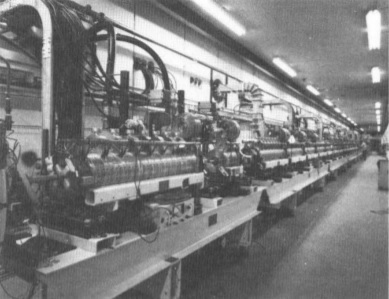Linac Reaches Upgrade Goal

Linac
On September 4 the new upgraded Linac reached 400 Mev, one week after the start of commissioning.
Commissioning began August 27, and at approximately 3:30 p.m. on September 4, the beam reached its new design energy goal.
Bob Noble of the Linac Department said they did not expect to get beam that fast. "The fact that it took only seven days to get 400-Mev beam out of the new Linac is really remarkable. Other linear accelerators take weeks of commissioning. It was more successful than anyone thought it would be."
The successful commissioning marks the efforts of many people involved with the Linac upgrade project. The project was designed to increase the beam energy from 200 Mev to 400 Mev. This in turn will create a 75% increase in the Booster beam intensity and produce a higher luminosity in the Tevatron. The commissioning is the first phase of the accelerator upgrades that will eventually culminate in the commissioning of the Main Injector. The upgrading of the Linac involved replacing the last four Linac drift tube cavities with seven modules of newly produced sidecoupled cavity accelerators.
The overall commissioning of the Linac has run very smoothly to date, said Bob. Other than a damaged 200kw varian klystron that was replaced on September 3, things have gone well. "It' s been remarkable how small the problems have been. We haven't had any major problems, other than the klystron."
The first two days following the approval to proceed with the commissioning involved setting up the old as well as new Linac. The Linac Department wanted to ensure that the parameters were set in order to bring up the old Linac, said Bob.
On August 30, beam was accelerated through the first of the seven modules at approximately 152 Mev. Over the rest of the week from August 31 to September 2, the Linac Department did a lot of transverse matching to get the beam down to the end of the Linac. Bob said that much time was spent determining what quadrupole settings should be set to in order to move the low-energy beam down the Linac. " it's not of any interest when you are accelerating beam, but for commissioning studies it is important for diagnostics."
On September 4 at approximately 3 a.m., beam was accelerated through Module three to 229 Mev. Over the next 12 hours, said Bob, things moved continuously and sequentially. "We got modules four, five, six and then by 3:30 p.m. we got module seven at 400 Mev. It was pretty rapid at that point. The transmission through the Linac was roughly 80% transmission--which is decent for a first pass through the machine."
Bob said there is still more work ahead. The commissioning is expected to continue for four more weeks. In that time, the Linac Department wants to reduce the percentage loss to one-tenth of a percent. Following the outcome of the shielding assessment, which was conducted on September 8, the department also wants to begin running at a higher current and pulse length. "Ultimately, we want to get back to 30 or 35 milliamps and 30 to 40 microseconds of beam pulse, which is what the Linac used to run at," said Bob.
Their final push is now to get the beam transferred down the transfer line and injected into the Booster. "Technically the (upgrade) project ends when the beam crosses the stripping foil and is injected into the Booster. Hopefully we will inject more intensity into the Booster as time goes on. The intention is that the Booster will preserve that intensity and transfer it to the other machines and use it to increase the luminosity."


